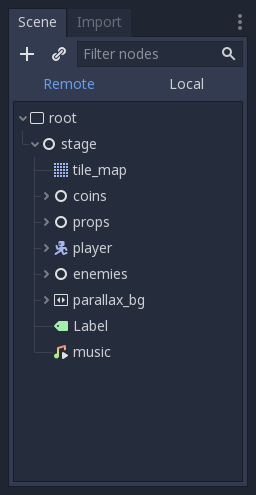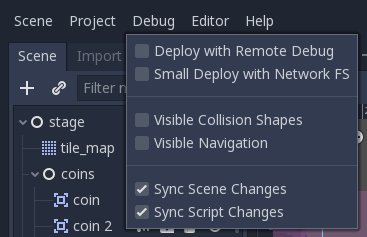Overview of debugging tools¶
This guide will give you an overview of the available debugging tools in the engine.
Godot comes with a powerful debugger and profilers to track down bugs, inspect your game at runtime, monitor essential metrics, and measure performances. It also offers options to visualize collision boxes and navigation polygons in the running game.
Finally, you have options to debug the game running on a remote device and to reload changes to your scenes or your code while the game is running.
Script editor debug tools and options¶
The script editor has its own set of debug tools for use with breakpoints and two options. The breakpoint tools can also be found in the Debugger tab of the debugger.

The Break button causes a break in the script like a breakpoint would. Continue makes the game continue after pausing at a breakpoint. Step Over goes to the next line of code, and Step Into goes into a function if possible. Otherwise, it does the same thing as Step Over.
The Keep Debugger Open option keeps the debugger open after a scene has been closed. And the Debug with External Editor option lets you debug your game with an external editor.
Debug project settings¶
In the project settings, there is a Debug category with three subcategories which control different things.
Settings¶
These are some general settings such as printing the current FPS to the Output panel, the maximum amount of functions when profiling and others.
GDScript¶
These settings allow you to toggle specific GDScript warnings, such as for unused variables. You can also turn off warnings completely.
Shapes¶
Shapes are where you can adjust the color of shapes that only appear for debugging purposes, such as collision and navigation shapes.
Debugging tools¶
You can find the debugger in the bottom panel. Click on Debugger to open it.

The debugger is split into several tabs, each focusing on a specific task.
Debugger¶
The debugger tab opens automatically when the GDScript compiler reaches a breakpoint in your code.
It gives you a stack trace, information about the state of the object, and buttons to control the program’s execution.
You can use the buttons in the top-right to:
- Skip all breakpoints. That way, you can save breakpoints for future debugging sessions.
- Copy the current error message.
- Step Into the code. This button takes you to the next line of code, and if it’s a function, it steps line-by-line through the function.
- Step Over the code. This button goes to the next line of code, but it doesn’t step line-by-line through functions.
- Break. This button pauses the game’s execution.
- Continue. This button resumes the game after a breakpoint or pause.
Errors¶
This is where errors and warning messages are printed while running the game.
Profiler¶
The debugger comes with three profilers for your processor, network operations, and video memory.
The profiler is used to show why individual frames take as long as they do to process and render.
Unlike other debugging tools, the profiler does not start automatically. It can be started at any time during gameplay by pressing the start button. You can even start the profiler before opening the game to profile startup performance. It can also be started and stopped while the game is running without losing information from when it was last running. The information it records won’t go away unless you click clear, or close the game, reopen it and start the profiler again.
After starting and stopping the profiler you should see things being kept track of on the left and a graph on the right. The items listed on the left are everything that contributes to frame time, and they should each have a value for time and calls for the current frame you are looking at.
The frame number in the top right tells you which frame you are currently looking at. You can change this by using the up or down arrows, typing in the frame number, or clicking on the graph.
If you want to add something to your graph, or think it looks too cluttered, you can check and uncheck the box next to an item to add or remove it from the graph.
Network Profiler¶
The Network Profiler contains a list of all the nodes that communicate over the multiplayer API and, for each one, some counters on the amount of incoming and outgoing network interactions. It also features a bandwidth meter that displays the total bandwidth usage at any given moment.
Monitors¶
The monitors are graphs of several aspects of the game while its running such as FPS, memory usage, how many nodes are in a scene and more. All monitors keep track of stats automatically, so even if one monitor isn’t open while the game is running, you can open it later and see how the values changed.
Video Memory¶
The Video Mem tab lists the video memory usage of the running game and the resources using it.
Misc¶
The Misc tab contains tools to identify the control nodes you are clicking at runtime:
- Clicked Control tells you where the clicked node is in the scene tree.
- Clicked Control Type tells you the type of the node you clicked is.
Remote in scene dock¶
When running a game in the editor two options appear at the top of the Scene dock, Remote and Local. While using Remote you can inspect or change the nodes’ parameters in the running project.

Note
Some editor settings related to debugging can be found inside the Editor Settings, under the Network > Debug and Debugger sections.
